803. Cape Sparrow Passer melanurus (Gewone Mossie)
Order: Passeriformes. Family: Passeridae
Description
It is 14-16 cm in length. This species with its black and white head pattern is more bunting-like than it is sparrow-like. It has brown legs and a brown coloured back. The eyes are brown.
Male is unmistakable: it is the only sparrow in the region to have a pied head. The breeding male has a mostly black head with a broad white mark from behind the eye to the throat. On the throat is a narrow black band. The underparts are greyish, darker on the flanks. The male’s back is neck is dark grey, and its back and shoulders are bright chestnut. The male has a white and a black wing bar below its shoulders, and flight feathers and tail streaked grey and black.
The female has a grey head with a different pattern from the male, though it bears a hint of the pale head markings of the male.
The juvenile is like the female, but young males show black on the head from an early age. The head is coloured black, white while the bill is coloured black.
Similar species: Female is distinguished from female House Sparrow and Great Sparrow by its plain chestnut back, and by its grey head and faint shadow markings of the male's pied head pattern.
Distribution: It is found in southern Africa, occurring from south-western Angola to Namibia (excluding the north-east), southern Botswana, south-western Zimbabwe and across South Africa, where it is particularly common.
Habitat
It prefers semi-arid savanna, thornveld, and light woodland. It occurs as well in urban centres and farmland.
Diet
It eats a variety of insects and plant products, such as seeds, fruit and nectar.
Breeding
Its breeding behaviour varies, as it is usually monogamous but sometimes polygynous, nesting either singly or in colonies of up to roughly 100 pairs. It often rears multiple broods in each breeding season. The nest is built by both sexes, consisting of an untidy hollow ball with an entrance tunnel on the side, made of grass, weed stems and pliable, woody plant fibres and lined with feathers or soft plant material. It is typically placed in a bush, tree, hollow fence post, telegraph pole crossbar, wire netting fence, under the eaves of a building or even in old swallow or weaver nest. Egg-laying season is mainly from August-March, peaking from August-November in the Western Cape, but peaking later from September-February in summer rainfall areas. It lays 2-6 eggs, which are incubated by both sexes for about 12-14 days. The chicks are brooded and fed by both adults on a diet of mainly insects, leaving the nest after 11-20 days. They usually remain dependent on their parents for food for about 1-2 weeks after fledging, but they sometimes only become independent at approximately two months old.
Call
The basic call is used in flight and while perching socially and transcribed as chissip, chirrup, chreep, or chirrichup. A call used by the male to advertise nest ownership is transcribed as tweeng or twileeng. Distinctive and loud, this call sometimes becomes a jerky and repetitive song, transcibed as chip cheerup, chip cheerup. Listen to Bird Call.
Status
Very common, near endemic resident.
Africa Wild Bird Book
Cape Sparrow Photos
803. Cape Sparrow Passer melanurus
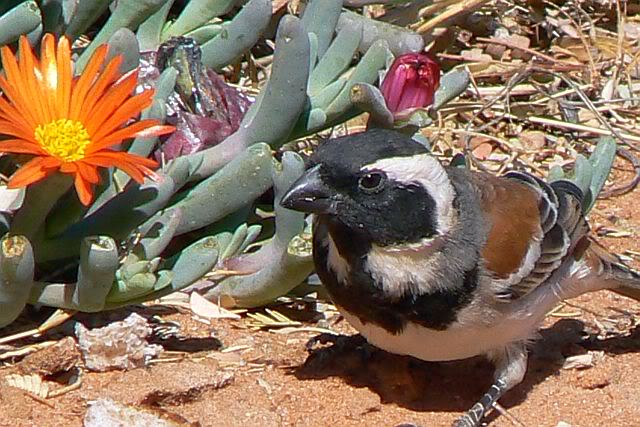 © Toko
© Toko
Male, Kgalagadi Trandfrontier Park, Twee Rivieren
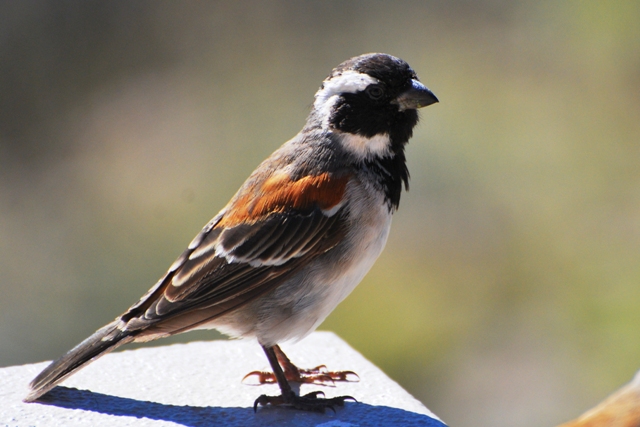 © Mel
© Mel
Male
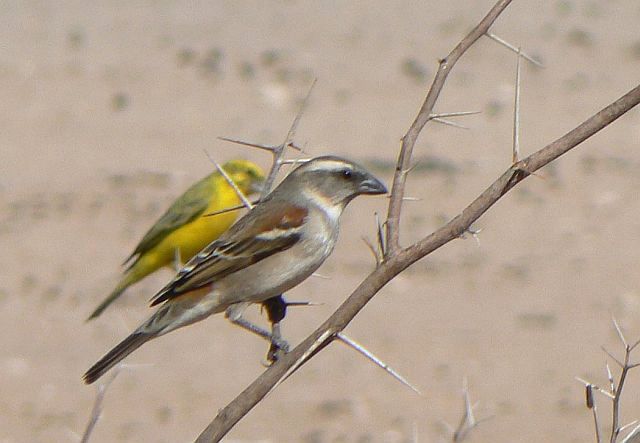
Female
 © Flutterby
© Flutterby
Rietvlei Nature Reserve, Gauteng
Links:
Species text Sabap1
Sabap2: http://sabap2.adu.org.za/spp_summary.ph ... §ion=3
Oiseaux net: http://www.oiseaux-birds.com/card-cape-sparrow.html
Denis Summers-Smith. The Sparrows
Fitzpatrick: The use of aromatic plants in Cape Sparrow nests
 © Toko
© TokoMale, Kgalagadi Trandfrontier Park, Twee Rivieren
 © Mel
© MelMale

Female
 © Flutterby
© FlutterbyRietvlei Nature Reserve, Gauteng
Links:
Species text Sabap1
Sabap2: http://sabap2.adu.org.za/spp_summary.ph ... §ion=3
Oiseaux net: http://www.oiseaux-birds.com/card-cape-sparrow.html
Denis Summers-Smith. The Sparrows
Fitzpatrick: The use of aromatic plants in Cape Sparrow nests
- Mel
- Global Moderator
- Posts: 26737
- Joined: Sat May 19, 2012 12:31 pm
- Country: Germany
- Location: Föhr
- Contact:
Southern Grey-headed Sparrow
804a. Southern Grey-headed Sparrow Passer diffusus (Gryskopmossie)
Order: Passeriformes. Family: Passeridae
Description
Length 15-16 cm, mass 24 g. Identified by grey head, chestnut shoulders and rump and single white shoulder-bar. The head is grey, the back brown, and the rump is bright rufous and conspicuous in flight. The wings have short, but usually obvious white wingbars. White to pale grey underparts. The eyes, legs and feet are brown, and the bill is black when breeding (horn when not breeding). Both sexes will change bill colour when breeding.
Juvenile is duller.
Similar species: It could be confused with the female Cape Sparrow but lacks any pale markings on its uniformly grey head.
In the northern extremity of its range (north of 19° S), it is easily confused with the very similar Northern Grey-headed Sparrow, which is slightly heavier with a longer tail and longer bill. The Northern Grey-headed Sparrow is also darker, with a less-distinct wing-bar.
Distribution
Occurs from western and southern Angola through Zambia to southern Africa, where it is fairly common to common across much of the region, excluding the arid west of Namibia and South Africa.
Habitat
Prefers savanna and woodlands, but can be found in a variety of habitats.
Diet
Mainly seeds, also insects, fruit and nectar. It does most of its foraging on the ground, often in flocks with other granivorous birds.
Breeding
It is a monogamous, usually solitary nester, although it occasionally breeds in loose colonies. The nest is built by both sexes, consisting of a simple pad of grass, leaf petioles, weed stems, hair and feathers. It is typically placed in a tree cavity, either natural or an abandoned nest of a Woodpecker or Barbet, or in a hole in a wall, or an old nest of another bird such as a Little Swift, swallow or a chamber of a Red-billed Buffalo-weaver colony. Egg-laying season is from September-June, peaking from about December-April. It lays 2-6 eggs, which are incubated by both sexes for about 11-14 days. The chicks are brooded and fed by both adults on a diet of insects, leaving the nest after about 16-19 days. The fledglings remain dependent on their parents for about 14-21 days more, but they still roost in the nest for a further 13-20 days.
Host of Diderick Cuckoo and Greater Honeyguide.
Call
Repetitive khrip, kroep, krip and similar notes. Listen to Bird Call.
Status
Common resident, sedentary but locally nomadic in arid regions. Gregarious in non-breading season.
Order: Passeriformes. Family: Passeridae
Description
Length 15-16 cm, mass 24 g. Identified by grey head, chestnut shoulders and rump and single white shoulder-bar. The head is grey, the back brown, and the rump is bright rufous and conspicuous in flight. The wings have short, but usually obvious white wingbars. White to pale grey underparts. The eyes, legs and feet are brown, and the bill is black when breeding (horn when not breeding). Both sexes will change bill colour when breeding.
Juvenile is duller.
Similar species: It could be confused with the female Cape Sparrow but lacks any pale markings on its uniformly grey head.
In the northern extremity of its range (north of 19° S), it is easily confused with the very similar Northern Grey-headed Sparrow, which is slightly heavier with a longer tail and longer bill. The Northern Grey-headed Sparrow is also darker, with a less-distinct wing-bar.
Distribution
Occurs from western and southern Angola through Zambia to southern Africa, where it is fairly common to common across much of the region, excluding the arid west of Namibia and South Africa.
Habitat
Prefers savanna and woodlands, but can be found in a variety of habitats.
Diet
Mainly seeds, also insects, fruit and nectar. It does most of its foraging on the ground, often in flocks with other granivorous birds.
Breeding
It is a monogamous, usually solitary nester, although it occasionally breeds in loose colonies. The nest is built by both sexes, consisting of a simple pad of grass, leaf petioles, weed stems, hair and feathers. It is typically placed in a tree cavity, either natural or an abandoned nest of a Woodpecker or Barbet, or in a hole in a wall, or an old nest of another bird such as a Little Swift, swallow or a chamber of a Red-billed Buffalo-weaver colony. Egg-laying season is from September-June, peaking from about December-April. It lays 2-6 eggs, which are incubated by both sexes for about 11-14 days. The chicks are brooded and fed by both adults on a diet of insects, leaving the nest after about 16-19 days. The fledglings remain dependent on their parents for about 14-21 days more, but they still roost in the nest for a further 13-20 days.
Host of Diderick Cuckoo and Greater Honeyguide.
Call
Repetitive khrip, kroep, krip and similar notes. Listen to Bird Call.
Status
Common resident, sedentary but locally nomadic in arid regions. Gregarious in non-breading season.
God put me on earth to accomplish a certain amount of things. Right now I'm so far behind that I'll never die.
- Mel
- Global Moderator
- Posts: 26737
- Joined: Sat May 19, 2012 12:31 pm
- Country: Germany
- Location: Föhr
- Contact:
Southern Grey-headed Sparrow Photos
804a. Southern Grey-headed Sparrow Passer diffusus
 © Mel
© Mel
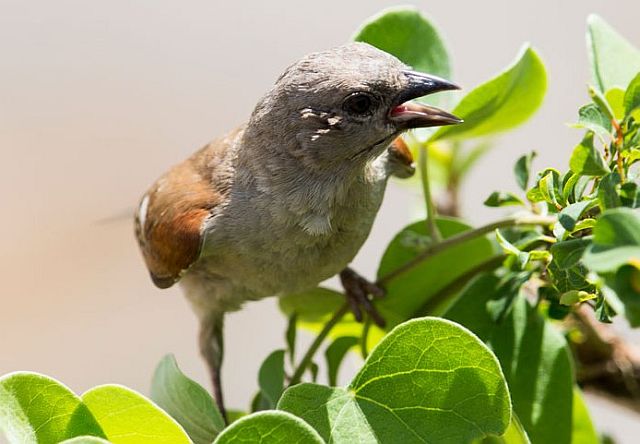 © Pumbaa & Timon
© Pumbaa & Timon
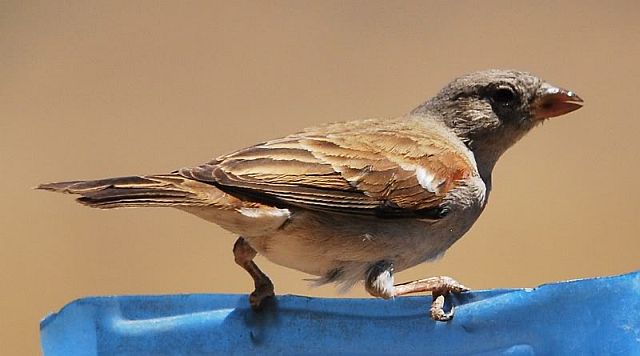 © Mel
© Mel
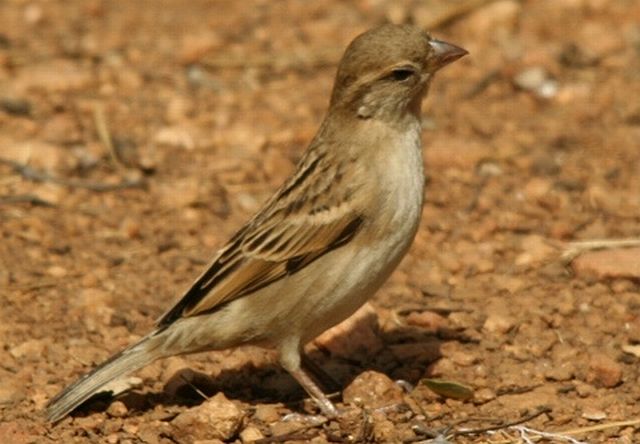 © pooky
© pooky
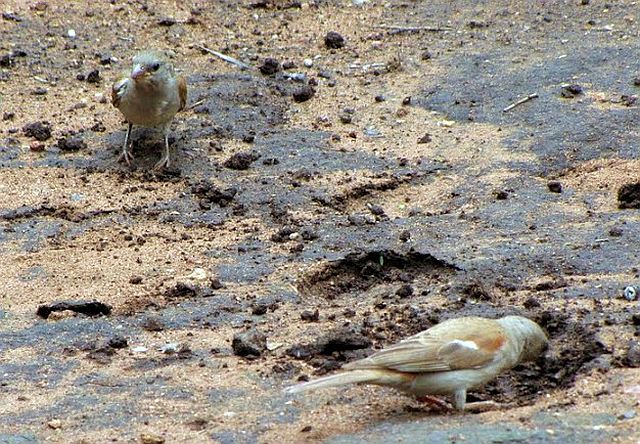 © Lisbeth
© Lisbeth
Links:
Species text in The Atlas of Southern African Birds
Sabap2: http://sabap2.adu.org.za/spp_summary.ph ... §ion=3
Southern Greyheaded Sparrows Passer diffusus range expansion in the Western Cape
Chamberlain's LBJs
 © Mel
© Mel © Pumbaa & Timon
© Pumbaa & Timon © Mel
© Mel © pooky
© pooky © Lisbeth
© LisbethLinks:
Species text in The Atlas of Southern African Birds
Sabap2: http://sabap2.adu.org.za/spp_summary.ph ... §ion=3
Southern Greyheaded Sparrows Passer diffusus range expansion in the Western Cape
Chamberlain's LBJs
God put me on earth to accomplish a certain amount of things. Right now I'm so far behind that I'll never die.
- Flutterby
- Posts: 44029
- Joined: Sat May 19, 2012 12:28 pm
- Country: South Africa
- Location: Gauteng, South Africa
- Contact:
Yellow-throated Bush-sparrow
805. Yellow-throated Bush-sparrow Gymnoris superciliaris formerly known as Yellow-throated Petronia Petronia superciliaris
Order: Passeriformes. Family: Passeridae
Description
15-16 cm. Dusky brown above. Dark head with a broad, creamy white eyebrow stripe, bordered below by blackish-brown eyestripe. Dusky streaked back. Pale buffish tips on upperwing-coverts. Dark brown tail with narrow pale or warm buffish-brown edges. Whitish chin, white throat. Yellow spot on lower throat. Brownish-grey underparts. Robust brown bill with paler lower mandible (more rarely a pink to pale bill). Sexes similar.
Juveniles are like adults but warmer brown and with a buffish supercilium and lack the yellow on the throat.
Similar species: Similar to White-browed Sparrow-Weaver which is larger, whiter below, broader white supercilium, and has white rump.
Distribution
It is found in sub-Equatorial Africa from southern DRC through southern Tanzania, Zambia, Angola and Malawi to southern Africa. Here it is fairly common in northern Namibia (including the Caprivi Strip), northern and south-eastern Botswana, Zimbabwe, Mozambique and eastern South Africa, while more scarce further west to the Eastern Cape and the North-West Province.
Habitat
Open woodland with sparse grass.
Diet
Insects, also seeds and nectar.
Breeding
Monogamous. Nests in natural holes, or in old barbet and woorpecker holes in trees.
Parasitised by Greater Honeyguide and Brown-backed Honeybird.
Call
3-4 loud, evenly pitched tri-tri-tri notes. Listen to Bird Call.
Status
Fairly common resident.
Order: Passeriformes. Family: Passeridae
Description
15-16 cm. Dusky brown above. Dark head with a broad, creamy white eyebrow stripe, bordered below by blackish-brown eyestripe. Dusky streaked back. Pale buffish tips on upperwing-coverts. Dark brown tail with narrow pale or warm buffish-brown edges. Whitish chin, white throat. Yellow spot on lower throat. Brownish-grey underparts. Robust brown bill with paler lower mandible (more rarely a pink to pale bill). Sexes similar.
Juveniles are like adults but warmer brown and with a buffish supercilium and lack the yellow on the throat.
Similar species: Similar to White-browed Sparrow-Weaver which is larger, whiter below, broader white supercilium, and has white rump.
Distribution
It is found in sub-Equatorial Africa from southern DRC through southern Tanzania, Zambia, Angola and Malawi to southern Africa. Here it is fairly common in northern Namibia (including the Caprivi Strip), northern and south-eastern Botswana, Zimbabwe, Mozambique and eastern South Africa, while more scarce further west to the Eastern Cape and the North-West Province.
Habitat
Open woodland with sparse grass.
Diet
Insects, also seeds and nectar.
Breeding
Monogamous. Nests in natural holes, or in old barbet and woorpecker holes in trees.
Parasitised by Greater Honeyguide and Brown-backed Honeybird.
Call
3-4 loud, evenly pitched tri-tri-tri notes. Listen to Bird Call.
Status
Fairly common resident.
- Flutterby
- Posts: 44029
- Joined: Sat May 19, 2012 12:28 pm
- Country: South Africa
- Location: Gauteng, South Africa
- Contact:
Yellow-throated Bush-sparrow Photos
805. Yellow-throated Bush-sparrow Gymnoris superciliaris
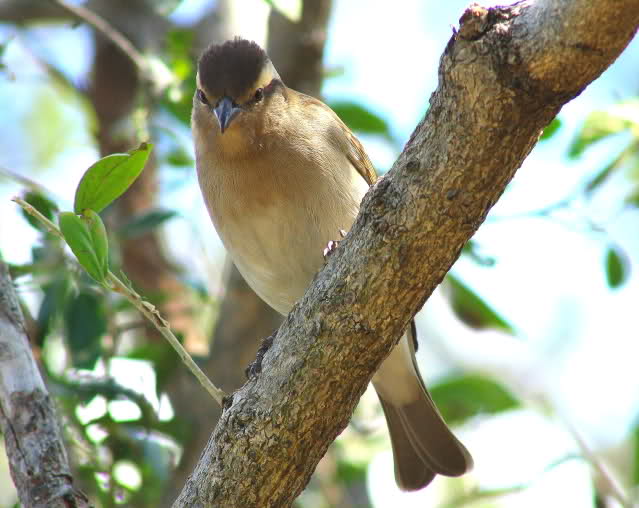 © Flutterby
© Flutterby
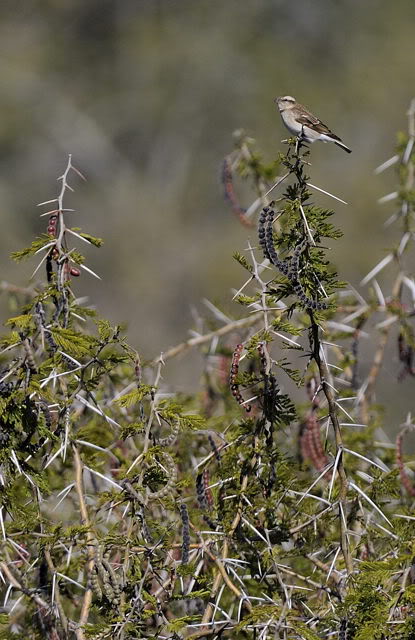 © Dewi
© Dewi
Kwa-Zulu Natal
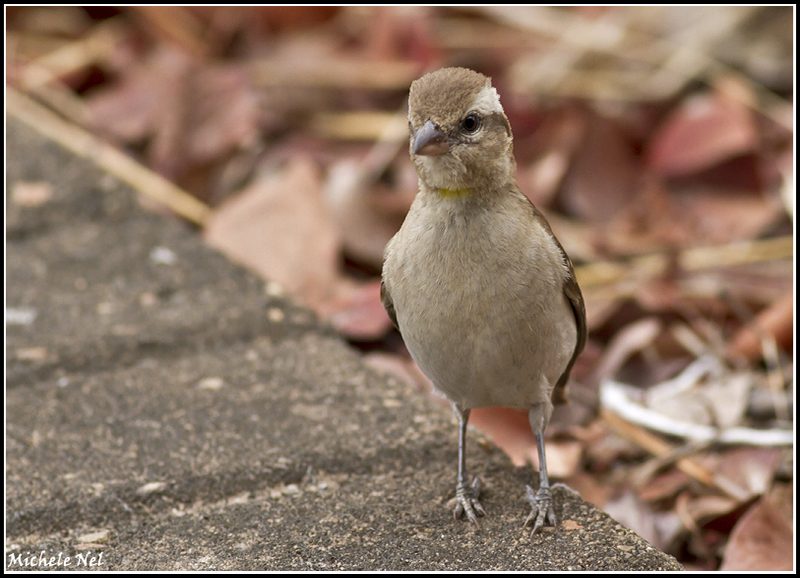
Kruger National Park © Michele Nel
Links:
Species text Sabap1
Sabap2
 © Flutterby
© Flutterby © Dewi
© DewiKwa-Zulu Natal

Kruger National Park © Michele Nel
Links:
Species text Sabap1
Sabap2
Family Ploceidae (Weavers, Widowbirds)
The Ploceidae, or weavers, are small passerine birds related to the finches.
These are seed-eating birds with rounded conical bills, most of which are from Sub-Saharan Africa, with fewer species in tropical Asia. A few species have been introduced outside their native range. The weaver group is divided into the buffalo, typical, and widow weavers. There are 109 present species in the family of Ploceidae.
The males of many species are brightly coloured, usually in red or yellow and black, some species show variation in colour only in the breeding season.
Weaver birds, also known as weaver finches, get their name because of their elaborately woven nests (the most elaborate of any birds'), though some are notable for their selective parasitic nesting habits. The nests vary in size, shape, material used, and construction techniques from species to species. Materials used for building nests include fine leaf-fibers, grass, and twigs. Many species weave very fine nests using thin strands of leaf fiber, though some, like the buffalo-weavers, form massive untidy stick nests in their colonies, which may have spherical woven nests within. Most species weave nests that have narrow entrances, facing downward.
Many weaver species are gregarious and breed colonially. The birds build their nests together for protection, often several to a branch. Usually the male birds weave the nests and use them as a form of display to lure prospective females. The weaver bird colonies may be found close to water bodies. They sometimes cause crop damage, notably the Red-billed Quelea, reputed to be the world's most numerous bird.
Links:
South Africa's Weavers
These are seed-eating birds with rounded conical bills, most of which are from Sub-Saharan Africa, with fewer species in tropical Asia. A few species have been introduced outside their native range. The weaver group is divided into the buffalo, typical, and widow weavers. There are 109 present species in the family of Ploceidae.
The males of many species are brightly coloured, usually in red or yellow and black, some species show variation in colour only in the breeding season.
Weaver birds, also known as weaver finches, get their name because of their elaborately woven nests (the most elaborate of any birds'), though some are notable for their selective parasitic nesting habits. The nests vary in size, shape, material used, and construction techniques from species to species. Materials used for building nests include fine leaf-fibers, grass, and twigs. Many species weave very fine nests using thin strands of leaf fiber, though some, like the buffalo-weavers, form massive untidy stick nests in their colonies, which may have spherical woven nests within. Most species weave nests that have narrow entrances, facing downward.
Many weaver species are gregarious and breed colonially. The birds build their nests together for protection, often several to a branch. Usually the male birds weave the nests and use them as a form of display to lure prospective females. The weaver bird colonies may be found close to water bodies. They sometimes cause crop damage, notably the Red-billed Quelea, reputed to be the world's most numerous bird.
Links:
South Africa's Weavers
Family Ploceidae (Weavers, Widowbirds) Index
Family Ploceidae (Weavers, Widowbirds)
Bubalornis niger Red-billed Buffalo Weaver 798
Plocepasser mahali White-browed Sparrow-Weaver 799
Philetairus socius Sociable Weaver 800
Sporopipes squamifrons Scaly-feathered Weaver (Scaly-feathered Finch) 806
Amblyospiza albifrons Thick-billed Weaver 807
Ploceus ocularis Spectacled Weaver 810
Ploceus capensis Cape Weaver 813
Ploceus subaureus Eastern Golden Weaver (Yellow Weaver) 817
Ploceus xanthops Holub's Golden Weaver (Golden Weaver) 816
Ploceus xanthopterus Southern Brown-throated Weaver 818
Ploceus intermedius Lesser Masked Weaver 815
Ploceus velatus Southern Masked Weaver 814
Ploceus cucullatus Village Weaver 811
Ploceus rubiginosus Chestnut Weaver 812
Ploceus bicolor Dark-backed Weaver 808
Ploceus olivaceiceps Olive-headed Weaver 809
Anaplectes rubriceps Red-headed Weaver 819
Quelea cardinalis Cardinal Quelea 823
Quelea erythrops Red-headed Quelea 822
Quelea quelea Red-billed Quelea 821
Euplectes afer Yellow-crowned Bishop 826
Euplectes hordeaceus Black-winged Red Bishop 825
Euplectes orix Southern Red Bishop 824
Euplectes capensis Yellow Bishop 827
Euplectes axillaris Fan-tailed Widowbird 828
Euplectes macroura Yellow-mantled Widowbird 830
Euplectes albonotatus White-winged Widowbird 829
Euplectes ardens Red-collared Widowbird 831
Euplectes progne Long-tailed Widowbird 832
Bubalornis niger Red-billed Buffalo Weaver 798
Plocepasser mahali White-browed Sparrow-Weaver 799
Philetairus socius Sociable Weaver 800
Sporopipes squamifrons Scaly-feathered Weaver (Scaly-feathered Finch) 806
Amblyospiza albifrons Thick-billed Weaver 807
Ploceus ocularis Spectacled Weaver 810
Ploceus capensis Cape Weaver 813
Ploceus subaureus Eastern Golden Weaver (Yellow Weaver) 817
Ploceus xanthops Holub's Golden Weaver (Golden Weaver) 816
Ploceus xanthopterus Southern Brown-throated Weaver 818
Ploceus intermedius Lesser Masked Weaver 815
Ploceus velatus Southern Masked Weaver 814
Ploceus cucullatus Village Weaver 811
Ploceus rubiginosus Chestnut Weaver 812
Ploceus bicolor Dark-backed Weaver 808
Ploceus olivaceiceps Olive-headed Weaver 809
Anaplectes rubriceps Red-headed Weaver 819
Quelea cardinalis Cardinal Quelea 823
Quelea erythrops Red-headed Quelea 822
Quelea quelea Red-billed Quelea 821
Euplectes afer Yellow-crowned Bishop 826
Euplectes hordeaceus Black-winged Red Bishop 825
Euplectes orix Southern Red Bishop 824
Euplectes capensis Yellow Bishop 827
Euplectes axillaris Fan-tailed Widowbird 828
Euplectes macroura Yellow-mantled Widowbird 830
Euplectes albonotatus White-winged Widowbird 829
Euplectes ardens Red-collared Widowbird 831
Euplectes progne Long-tailed Widowbird 832
Red-billed Buffalo-weaver
798. Red-billed Buffalo-weaver Bubalornis niger (Buffelwever)
Order: Passeriformes. Family: Ploceidae
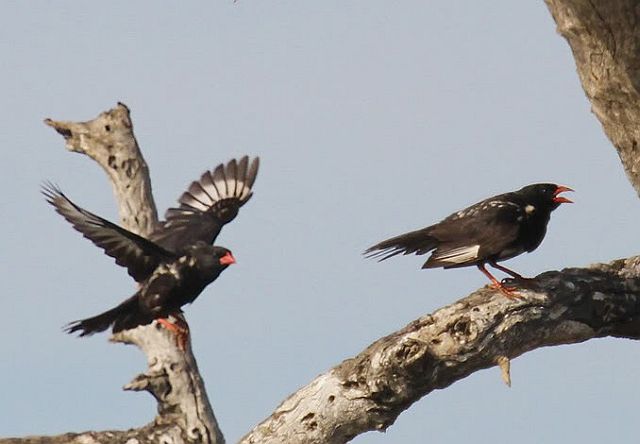 © leachy
© leachy
Description
Male is black with lightly white-flecked shoulder patches and primary edges very distinctive. White wing patches conspicuous in flight. Bill red or sometime orange.
Female is duller than male, more brownish black, especially on underparts, which have white mottling.
Juvenile resembles female but underparts are white, streaked dark brown.
Distribution
Occurs in two separate areas of sub-Saharan Africa; one extending from Somalia and Ethiopia through to Tanzania and the other population from southern DRC, Angola and Zambia to southern Africa. Here it is locally common from northern and central Namibia to Botswana, Zimbabwe, southern Mozambique and northern and north-eastern South Africa.
Habitat:They are found in savanna, thornveld and dry woodland, mostly in Acacia savanna, especially when it has been disturbed by humans and livestock.
Diet
It feeds mainly on insects, particularly grasshoppers and caterpillars, but also takes seeds and fruit. It forages on the ground, searching the soil and low vegetation for food.
Breeding
This species is usually polygynous, with one male and several females occupying a nest. It is breeds in colonies made up of different separate "lodges", each with a number of nesting chambers within them. The males may be polygamous, each controlling 1-8 nest chambers and up to about 3 females; usually there is one dominant male in a colony who has the most females and egg chambers, while other males may have one female and a few chambers. The males vigorously defend their lodges against other males, using aggressive displays and calls, and females within harem do not tolerate each others presence in their egg chambers. Colonies may use a different system altogether, with two males cooperating with each other to build the nest, both defending the territory and helping to feed the chicks. The nest is a huge, bulky mass of interconnected thorny twigs, divided into separate complexes (lodges) with multiple egg chambers, each with a nest built by the female, consisting of a ball of grass, leaves and roots. The colony is typically placed in the branches of a large, often thorny tree or alternatively a windmill or pylon, usually near human habitation. In fact if the people in the area leave, the colony often departs as well. Large raptors such as White-backed vultures (Gyps africanus) and Bateleurs (Terathopius ecaudatus) often build their nests on top of Red-billed Buffalo-weaver nests; this is though to be mutually beneficial, as the raptor nests are camouflaged and the weavers are protected from other predators.
Call
Male gives loud lookatit-lookatit-lookatit or widdla-widdla-widdla; female gives musical chwee. Listen to Bird Call.
Status
Locally common resident. Generally sedentary in north and west but a summer visitor to South African lowveld. Gregarious; usually in small flocks.
Order: Passeriformes. Family: Ploceidae
 © leachy
© leachyDescription
Male is black with lightly white-flecked shoulder patches and primary edges very distinctive. White wing patches conspicuous in flight. Bill red or sometime orange.
Female is duller than male, more brownish black, especially on underparts, which have white mottling.
Juvenile resembles female but underparts are white, streaked dark brown.
Distribution
Occurs in two separate areas of sub-Saharan Africa; one extending from Somalia and Ethiopia through to Tanzania and the other population from southern DRC, Angola and Zambia to southern Africa. Here it is locally common from northern and central Namibia to Botswana, Zimbabwe, southern Mozambique and northern and north-eastern South Africa.
Habitat:They are found in savanna, thornveld and dry woodland, mostly in Acacia savanna, especially when it has been disturbed by humans and livestock.
Diet
It feeds mainly on insects, particularly grasshoppers and caterpillars, but also takes seeds and fruit. It forages on the ground, searching the soil and low vegetation for food.
Breeding
This species is usually polygynous, with one male and several females occupying a nest. It is breeds in colonies made up of different separate "lodges", each with a number of nesting chambers within them. The males may be polygamous, each controlling 1-8 nest chambers and up to about 3 females; usually there is one dominant male in a colony who has the most females and egg chambers, while other males may have one female and a few chambers. The males vigorously defend their lodges against other males, using aggressive displays and calls, and females within harem do not tolerate each others presence in their egg chambers. Colonies may use a different system altogether, with two males cooperating with each other to build the nest, both defending the territory and helping to feed the chicks. The nest is a huge, bulky mass of interconnected thorny twigs, divided into separate complexes (lodges) with multiple egg chambers, each with a nest built by the female, consisting of a ball of grass, leaves and roots. The colony is typically placed in the branches of a large, often thorny tree or alternatively a windmill or pylon, usually near human habitation. In fact if the people in the area leave, the colony often departs as well. Large raptors such as White-backed vultures (Gyps africanus) and Bateleurs (Terathopius ecaudatus) often build their nests on top of Red-billed Buffalo-weaver nests; this is though to be mutually beneficial, as the raptor nests are camouflaged and the weavers are protected from other predators.
Call
Male gives loud lookatit-lookatit-lookatit or widdla-widdla-widdla; female gives musical chwee. Listen to Bird Call.
Status
Locally common resident. Generally sedentary in north and west but a summer visitor to South African lowveld. Gregarious; usually in small flocks.
Red-billed Buffalo-weaver Photos
798. Red-billed Buffalo-weaver Bubalornis niger (Buffelwever)
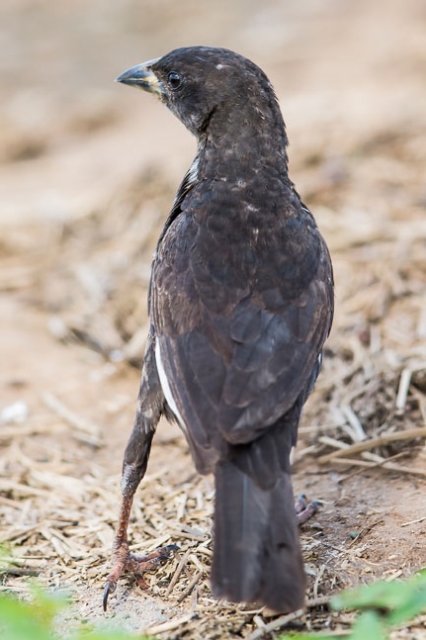 © Pumbaa
© Pumbaa
Juvenile, Sunset dam, Kruger National Park
 © Pumbaa
© Pumbaa
 © Flutterby
© Flutterby
Male
 © Flutterby
© Flutterby
Female
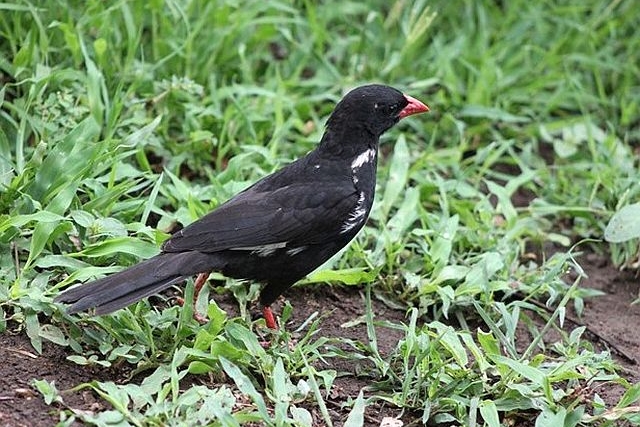 © Heksie
© Heksie
Kruger National Park
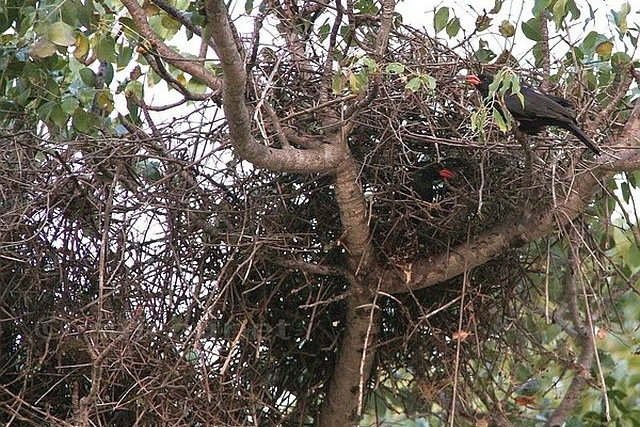 © nan
© nan
Kruger National Park
Links:
http://sabap2.adu.org.za/docs/sabap1/798.pdf
http://sabap2.adu.org.za/spp_summary.ph ... §ion=3
Weaver Wednesday: Red-billed Buffalo-Weaver
 © Pumbaa
© Pumbaa Juvenile, Sunset dam, Kruger National Park
 © Pumbaa
© Pumbaa  © Flutterby
© FlutterbyMale
 © Flutterby
© FlutterbyFemale
 © Heksie
© HeksieKruger National Park
 © nan
© nanKruger National Park
Links:
http://sabap2.adu.org.za/docs/sabap1/798.pdf
http://sabap2.adu.org.za/spp_summary.ph ... §ion=3
Weaver Wednesday: Red-billed Buffalo-Weaver


